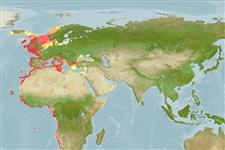Classificação / Names
Common names from other countries
Referência principal
Tamanho / Peso / Idade
Max length : 105 cm TL macho/indeterminado; (Ref. 53748); 139.0 cm TL (female); common length : 85.0 cm TL macho/indeterminado; (Ref. 9987); Peso máx. publicado: 18.0 kg (Ref. 35388); Idade máx. registada: 15 anos (Ref. 41305)
Length at first maturity
Lm 76.6, range 47 - 87.5 cm
Ambiente
; marinhas demersal; intervalo de profundidade 10 - 577 m (Ref. 56504)
Clima / Intervalo
Subtropical, preferred 17°C (Ref. 107945); 70°N - 29°S, 25°W - 42°E
Distribuição
Eastern Atlantic: Iceland, Norway, North Sea and the western Baltic southward to Morocco and Namibia, including the Mediterranean and the Black Sea. Although reported from southern Africa, its status in the area is uncertain (Ref. 5578).
Países | Áreas FAO | Ecossistemas | Ocorrências | Introduções
Descrição breve
Espinhos dorsais (total): 0; Espinhos anais 0; Raios anais moles: 0. Sub-rhomboid in shape with pointed wing-tips; disc-width 1,25 to 1,36 times in its length, its length 1,70 to 1,83 times in total length. Short rostrum, rounded at his extremity; pectoral fins with clear angles on lateral side; triangular pelvic fins (Ref. 39246). Dorsally prickly; large females also prickly throughout their ventral surface; juveniles and large males prickly along the margins of their discs and the underside of their snout. 30-50 thorns form a median row from the nape to the first dorsal fin; additional large 'buckler' thorns with swollen bases scattered on upper surface of disc in adults (Ref. 3167). Coloration is highly variable, with the dorsal surface having all shades of brown with dark and light spots and blotches; ventral surface white (Ref. 3167, 58137).
Categoria na Lista Vermelha da IUCN (Ref. 115185)
Ameaça para o homem
Harmless
Utilização humana
Pescarias: espécies comerciais; peixe desportivo: sim
Ferramentas
Relatórios especiais
Descarregue XML
Fontes da internet
Estimates of some properties based on models
Phylogenetic diversity index
PD50 = 0.5000 many relatives (e.g. carps) 0.5 - 2.0 few relatives (e.g. lungfishes)
Nível Trófico
3.8 ±0.2 se; Based on diet studies.
Resiliência
Baixo, tempo mínimo de duplicação da população 4,5 - 14 anos (K=0.09-0.14; tm=10; tmax=23; Fec=150)
Vulnerabilidade
High to very high vulnerability (72 of 100)
Categoria de preço
